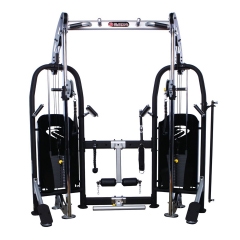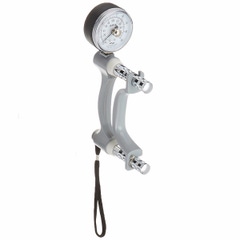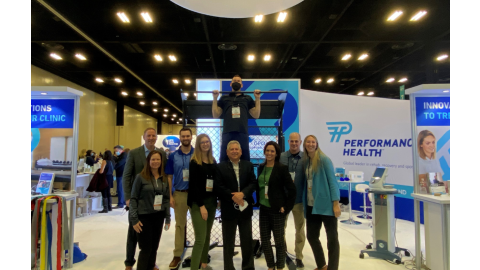Lindsey Plass PT, DPT, OCS, FAAOMPT, is a Fellow of the American Academy of Orthopedic Manual Physical Therapists. She has been practicing for almost 10 years and is currently practicing at the University of Chicago Medicine. She is also a faculty member in the University of Chicago Medicine Orthopedic Physical Therapy Residency and University of Chicago Orthopedic Manual Physical Therapy Fellowship.
Read below to learn about how she chose to become a Physical Therapist, her advice for new PTs, and more.
Lindsey Plass PT, DPT, OCS, FAAOMPT

What was it that made you want to get into the profession?
In high school, I went to a physical therapist who helped me when I had plantar fasciitis. Because of my physical therapist, I was able to continue to train and play at a high level that entire summer in basketball and soccer. That physical therapist opened my eyes to the profession, and I found it awesome that you got to help people move better, decrease their pain, and get back to doing the things they love.
I then volunteered at Marianjoy Acute Rehab Hospital where I discovered a completely different specialty of physical therapy, rehab for people after different neurological conditions like stroke, traumatic brain injury, brain surgery, etc. Seeing how compassionate the therapists were at Marianjoy and the amazing impact they were able to have on the patients really inspired me. This profession is so powerful! We learn so much from our patients daily and the ability to establish a rapport with patients where I can teach them things about recovery and they teach me things about life, makes being a physical therapist one of most rewarding careers!
My mom was a teacher and so my whole life I saw what positive impact she had on all her students. It really inspired me to want to go into a profession where I could help other people. There are a lot of similarities between teaching and physical therapy. So much of what we do as physical therapists involves teaching our patients how to help themselves and manage their conditions/recover from injury.
Do you have any specializations? What made you get these specializations and how do they help your patients?
After I graduated from Northwestern University in 2012 with my Doctor of Physical Therapy degree, I worked at the University of Chicago Medicine for two years. I then decided I wanted to specialize in orthopedics and moved to Baltimore in 2014 to begin an Orthopedic Physical Therapy Residency. I completed the Johns Hopkins Hospital and George Washington University Orthopedic Physical Therapy Residency in 2015.
I became a board certified Orthopedic Clinical Specialist in 2016. Then I completed the University of Chicago Medicine Orthopedic Manual Therapy Fellowship in 2019. Currently, I am a Fellow of the American Academy of Orthopedic Manual Physical Therapists. I am practicing at the University of Chicago Medicine, and I am also a faculty member at the University of Chicago Medicine Orthopedic Physical Therapy Residency and University of Chicago Orthopedic Manual Physical Therapy Fellowship.
How does your career as a physical therapist extend beyond your daytime job?
My clinical and research interests include treating runners and triathletes, people with chronic and persistent pain, and people with femoroacetabular impingement syndrome with/without labral tears. I am a former collegiate soccer player turned avid marathon runner and long course triathlete. It was my own hip journey with FAI/labral tear that sparked my interest in helping others with hip issues get back to doing the things they love.
One way my career has extended beyond my day job was in 2021, a highlight of my career. I was invited to be a part of the international Young Athlete’s Hip Research (YAHiR) Collaboration led by Dr. Henrik (Paul) Dijkstra who is the Director of Medical Education at Aspetar. The aim of the YAHiR Delphi Study and Collaboration is to contribute to improving the quality of research and clinical management of primary cam morphology.
How has the profession changed since you started? Where do you see it going from here?
There is now so much more awareness of how what we say to patients can positively or negatively impact their recovery. We now know that a lot of “conditions” are quite common in people who do not have pain and this why we must really treat the person and their symptoms and not just go off what imaging shows. Over-diagnosing and giving patients unnecessary labels can cause catastrophizing and fear avoidant behaviors. One of my favorite quotes is, “treat the person, not the image”.
The other key component I am really passionate about that is now recognized as an essential part of rehab is psychological readiness. We now have outcome measures such as the ACL-RSI (return to sport index) and Hip-RSI that can be utilized to screen patients and assess their psychological readiness. We now know that as physical therapists it is crucial that we help patients not just get “back to playing their sport” but really get back to “performing at high level in their sport”.
There is still so much that needs to be done when it comes to returning to sport testing and making sure that all physical therapists are utilizing objective and high-level testing before clearing patients to return to play. It is well understood that this is an area our profession needs to improve on and now it has become a matter of implementing better quality patient care and standards of care.
What are your top 5 must have items as a clinician?
- Pilates Reformer
- Treadmill
- Functional Training Cable Machine
- Handheld Dynamometer
- THERABAND Resistance Bands
How does Performance Health help you and your patients?
Performance Health helps me and my patients by enabling our clinic to be equipped with a wide variety of exercise equipment. Equipment pieces like the Total Gym and Shuttle Press enable us to help people strength train even if they have a tough time moving around. The adaptability of both machines makes it easy for patients to get on/off the machines as well as increasing the difficulty to promote tissue loading.
In the clinic I work at, we see a wide variety of patients from various socioeconomic statuses, and this is an especially important consideration when producing a home exercise program. Some patients will have access to gyms and therefore I can have them do exercises in the clinic using the cable machines, Pilate’s reformer, bikes, treadmills, etc. and they will be able to replicate it at their gym. Other patients may not have access to any equipment and therefore it becomes critical that I produce a plan utilizing equipment they have at home and equipment I am able to give them from our clinic, such as TheraBand resistance bands.
Who will be our next featured clinician? Nominate yourself or someone you know!

1. Click on the link below
2. Answer the questions on the form
3. Submit a photo of yourself
Medical Disclaimer: The information provided on this site, including text, graphics, images and other material are for informational purposes only and are not intended to substitute for professional medical advice, diagnosis or treatment. Always seek the advice of your physician or other healthcare professional with any questions or concerns you may have regarding your condition.








 France
France Australia
Australia











